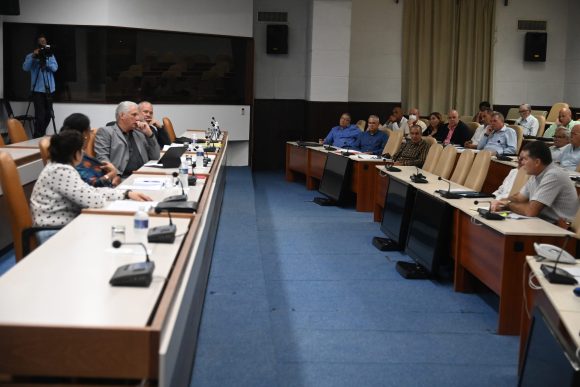
Havana, Oct 15.- Eliminating the effects on the electrical service, by increasing the generation capacity in the country and in turn energy efficiency, is one of the greatest challenges currently facing the National Electric System (SEN in Spanish): the paths to achieve this purpose are multiple and complex.
According to the explanation offered by engineer Lázaro Guerra Hernández, general director of Electricity of the Ministry of Energy and Mines (MINEM), in conversation with the Presidency's press team, the strategy followed for the generation of the SEN is prioritize national sources as support for the energy independence that Cuba needs.
To achieve this, it is essential, he assured, to have a “diversified generation matrix, which prioritizes its own sources, such as national crude oil; the gas accompanying the extraction of Cuban oil, and renewable energy sources.”
Regarding the last of these three topics, Guerra Hernández said that it is an issue, essentially scientific, that has been promoted more strongly in the national territory over the course of the last decade, since the approval in 2014 of the Policy for the prospective development of renewable energy sources and energy efficiency.
As part of this strategy, the use of photovoltaic solar energy has been promoted in Cuba, for which, since the beginning of 2024, an extensive investment process has been carried out that consists of two projects, the first of which will allow the installation of a thousand megawatts, in a period of two years. The second project, with the same amount of generation, must be ready in 2031.
“There are 26 photovoltaic solar parks that are currently in different phases of construction in all provinces, which means an enormous constructive effort for the country,” stressed Alfredo López Valdés, general director of the Unión Eléctrica, when exchanging with the press team.
The engineering of each park, he said, is science, and although the final result is very similar, the electrical conditions of each place are not exactly the same, which requires exhaustive work, from the moment the studies begin to select the place where each of them will be located.
Precisely all this effort carried out in the nation was the subject of analysis in the most recent meeting of the National Innovation Council chaired by the first secretary of the Central Committee of the Communist Party and president of the Republic, Miguel Díaz-Canel Bermúdez, where The first results of this cardinal project being undertaken were presented.
At that meeting, Doctor of Science Lídice Vaillant, head of the Photovoltaic Research Laboratory of the University of Havana, explained that nearly one million photovoltaic panels have already been installed, and another 3.6 million more panels will be assembled. This means, she highlighted that in two years the power that has been installed in the last ten years will be multiplied nearly five times, which represents a huge leap.
“Achieving the proposed installed power for 2031 would place Cuba at an estimated 12% of photovoltaic penetration in the country's energy generation,” she commented at the CNI meeting.
The two aforementioned projects, stated the general director of Electricity of the MINEN, have worked closely with the universities, to achieve a design that allows both to be adequately integrated into the National Electrical System.
The installation of the parks is a project exclusively based on science and innovation, she stressed. From its conception, it was necessary to think about how a generation as important as solar photovoltaic, which is also variable, was properly integrated into the National Electrical System, taking into account above all the paradigm shift in generation that this means, she said.
According to her assessment, there were many challenges that had to be overcome from a technical point of view to integrate this generation into the electrical system, especially taking into account how variable solar photovoltaic generation can be due to the behavior of the climate.
In addition to anticipating the possible impact on the system, she reflected, it is necessary to train the park operators, the builders, and in general all those involved in the completion of the projects.
This, he reaffirmed, is a holistic project, from its conceptualization to operation, since a significant number of entities in the country participate in it in an integrated manner.
Hence the importance given by Hernández Guerra to the presentation of the topic at the National Innovation Council, a space in which, based on the rigor of science, experts from universities and other scientific institutions made important suggestions in order to contribute to its improvement. .
That moment, he valued, became a closure for the research work carried out, which is one of constant study and evaluation, and has allowed us to have a more comprehensive design.
“It was a meeting in which this program was vigorously debated with the aim of making it work well,” considered the general director of the Electrical Union.
Science, innovation, organization, foresight, research, leadership, are essential elements that cannot be left out of hand for the execution and finally implementation of the designed project. Cuba needs all efforts to strengthen its Electrical System, and to do so, the use of science and innovation is essential. (Text: Yaima Puig Meneses/ Presidency of Cuba) (Photo: Presidency of Cuba)